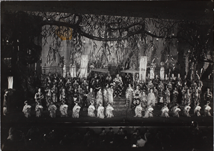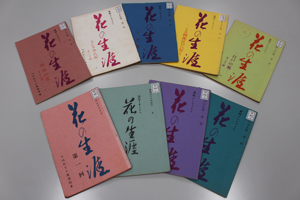Support Projects for Enhancing Function
Digitization and Sharing
of Theatre and Film-related Materials
Fiscal 2016
We will strengthen the Center's function by promoting the digitization of film-related non-film materials and numerous paper-based primary source materials
(scripts, magazines, drafts, etc.) held at the Theatre Museum. We shall also propose a new form of digital archive to be used for international academic exchanges. We have implemented projects based mainly on the following two points.
Digital Archive of materials related to Michio Ito
We proceeded to study materials related to Michio Ito, who became internationally successful as a dancer and choreographer mainly in Europe and the United States,
delivering a tremendous impact on modern dance overseas in the first half of the 20th century. In cooperation with the American NPO Michio Ito Foundation (founded by Michele Ito), which manages photographs and articles related to Michio Ito, we plan to release gradually materials on the website (Digital Archive Collection) the Theatre Museum has been operating.
The materials related to Michio Ito held at the Theatre Museum is a collection that draws strong interest overseas and has been highly awaited in Japan and
overseas for broad accessibility. From 2014 to 2015, our Center's selected research "The investigation and research into the Senda materials: Koreya Senda and contemporary plays" has made progress in the examination. This year, we proceeded to examine photographs that captured Michio Ito's childhood, stage performances, and life after the 191 Os, when he was in Europe and the United States, as well as those after the 1940s. We also went ahead with the investigation for copyright processing on the premise of making them available on the website. Further, we proceeded to examine materials related to the opening ceremony of the Tokyo Olympics, which Michio Ito was supposed to direct, and clippings from magazines and newspapers. Based on the outcome, we are preparing to release photographs from the 1930s, when he returned to Japan temporarily, those related to his performance at the Ernie Pyle Theater under the occupation in the late 1940s, those showing his activities at fashion shows and dance studio in the early 1950s, and his handwritten manuscripts.
To reveal the big picture of activities of Michio Ito, who became widely successful across genres anad regions, it becomes essential to share primary source
materials and develop an international research network. We hope that the digital archive of this collection will facilitate the international development of research on dance and Michio Ito, whose recognition is regaining interest mainly in the United States.

Photograph of Mikado, directed by Michio Ito
Digitization of TV Scripts during the Early Period
We will promote the preservation and utilization of script materials held at the Theatre Museum while fully utilizing our Center's newly purchased book scanner that can capture image data at the resolution equal to that of the National Diet Library. The number of scripts being released for digital viewing at libraries, such as the National Diet Library and Kawasaki City Museum, has increased. The Theatre Museum already implemented in-museum digital viewing of old scripts previously owned by Haruko Sugimura as well. We hope to develop a more systematic in-museum digital viewing system.
This year, we have focused on the TV scripts from the 1950s to the 1960s held at the museum when selecting titles to digitize. We have, thus far, carried out their
digital photo shooting. Items such as old scripts with handwritten annotations by successful actors who appeared in TV drama and those donated by institutions, such as TV stations, can be regarded as invaluable documents of television broadcasting since the earliest period. Specifically, we selected 39 books (a complete set) of old scripts of NHK's first historical drama series "Hana no Shogai" (1963), previously owned by Chikage Awashima who played the main character in the series,' "Hana no Shogai" (six books) from the old scripts previously owned by Keiji Sada, "Seishun Houkago" (1963, eight books), which was written by Yasujiro Ozu, and "Shichinin no Mago" (1964-1965) from the old collection of Hisaya Morishige. We are also studying the script of "Enoken no Mitolwmon Manyuki" (1954, a complete set of 14 episodes; the title of the first and second episodes was "Enoken no Komon Manyuki") and "Shakespeare Gekijo" (1954) from the 1950s, which broadcasted excerpts of Shakespeare's work. In a preliminary survey, we began to see the fruits of the study from both perspectives of preserving and researching materials, like discovering a material that records activities in the earliest days of TV stapled on the back of a script. We have also provisionally made the script "Hana no Shogai," previously owned by Awashima, available for in-museum digital viewing. We expect that the systematic digitization and utilization will make a significant contribution to the development of a new research area in the future.
We aim to continue promoting the project by fully utilizing technologies and physical resources at the Theatre Museum, flexibly and vigorously responding to
expectations from society by improving the quality of international academic exchanges as well as the ability to communicate to the world, and then building a solid research foundation that contributes exponentially to the development of theater and film research in Japan and abroad. (Fumito Shirai)

TV scripts Hana no shogai from the collection of Awashima Chikage